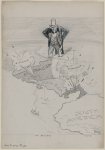
This political cartoon is titled “His Balkans” and was drawn by the artist Rollin Kirby. The cartoon is titled “His Balkans” because of the conflicts depicted in Central America, which are likened to the conflicts that occurred in the Balkans that led to World War I. The cartoon depicts Uncle Sam standing in the Caribbean Sea looking with worry over explosions occurring in Panama and Nicaragua (Kirby 1931). At the time, rebels in Panama had overthrown the government and Nicaragua was engaged in a conflict with the US. From 1912 to 1933, the US marines had occupied Nicaragua, which led to various military conflicts within the region. Most significantly, between 1927 and 1933, Augusto Cesar Sandino, a revolutionary, led the rebellion against the US marines that finally led to the end of their occupation of Nicaragua. The images of Uncle Sam and the explosions represent themes of intervention and resistance that categorized the Nationalism era.
The depiction of Uncle Sam represents the common practice of US intervention that occurred during the Nationalism period. The fact that he is watching the Central American conflicts with concern relates to the context of US-Latin American relationships through policies such as the Monroe Doctrine, which prohibited further European colonization of the Americas, and the Roosevelt Corollary, which allowed the US to intervene in conflicts in Latin American countries. These interventions eventually led to the type of resistance in the Nationalism period that is depicted by the explosions within the countries. Ultimately, the explosions depicted above Nicaragua, and Panama as well, highlight these nations’ long-held animosity toward the US and these nations’ desires to control their own country’s destiny, which are themes that were greatly prominent during the Nationalism era.
Works Cited
Kirby, Rollin. 1931. “His Balkans.”
By: Giovanny Bravo
